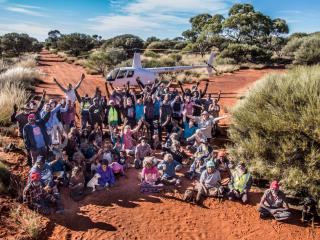For more than 600 generations and over 20,000 years the Great Victoria Desert, straddling the Western Australia/South Australia border, has been occupied by Southern Pitjantjatjara people, known contemporarily as the Spinifex People. The Anangu Tjutaku (many Aboriginal people) Indigenous Protected Area (IPA) represents the latest, but not the last, step in the Spinifex People’s articulation of their traditional and cultural connection and ownership of the region. The IPA comprises three native title determination areas – Spinifex, Pilki and Untiri Pulka.
The IPA consists of native vegetation that is overwhelmingly in pre-European condition and extent and contains threatened fauna species and endemic flora with localised distributions. Spanning a North-South transition in ecosystems ranging from the Nullarbor Plain and mulga woodlands of the Great Victoria Desert Nature Reserve in the south, through sand hill and salt lake country, into the breakaways and hills of the Central Ranges reserved in the Nganyaatjara IPA, the IPAs landscape-scale biodiversity values are immense. East to West, the IPA extends from the edge of the Greater Western Woodlands to the geographic centre of the Great Victoria Desert.
Complementing but transcending these natural values. the IPA is dense with culturally significant sites and Tjukurpa (dreaming or creation storylines). These include some of the most significant Tjukurrpa in the Western Desert, two of which occur predominantly within Spinifex Country. Knowledge of Tjukurrpa is alive and well among Spinifex People and has supported a connection to country that remained largely unbroken through the contact era.
The Spinifex Land Management Rangers are working to protect and manage the environmental and cultural assets across the Anangu Tjutaku IPA. The team also contract their land management services to the Mamungari Co-management Board for the 21,000 km2 Mamungari Conservation Park in South Australia. Spinifex Rangers are based in the Tjuntjuntjara community, and organise opportunities for community members to visit country and continue intergenerational knowledge transfer and cultural practices; are re-introducing traditional burning practices into the landscape; protect important cultural landscape features; survey and manage endangered flora and fauna; mentor school children through participation in the ‘Bushranger Program’; and, manage remote community safety infrastructure.
The Spinifex Land Management program works with a targeted group of partners, including the Indigenous Desert Alliance, Rangelands NRM, the Great Victoria Desert Adaptive Management Partnership, the Department of Parks and Wildlife (DPaW) and the Ten Deserts Initiative (through the Buffel Free GVD program).







